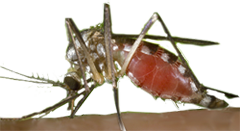By SCOTT MCKIE B.P.
ONE FEATHER STAFF
North Carolina has one of the highest rates of La Crosse encephalitis (LACV) in the country over the past few decades and Cherokee has been one of the hot beds for the disease. Last week, a representative from the Encephalitis Society, based in the United Kingdom, was in town to talk with victims of the diseases and their family and study the area for further analysis.
The CDC defines LACV as, “La Crosse encephalitis is a rare disease that is caused by a virus spread by infected mosquitoes. La Crosse encephalitis virus is one of a group of mosquito-transmitted viruses that can cause inflammation of the brain (encephalitis).”
Ava Easton, Encephalitis Society chief executive, gave a presentation at the Cherokee Indian Hospital on Monday, June 6 and addressed the EBCI Health Board in the Council Chambers on Wednesday, June 8.
“People have said talking to others who have been through this illness is better than any professional counseling,” Easton said Wednesday. “Working together, I think we’re stronger.”
Easton plans to report back to the Tribe her findings and recommendations with how to better deal with the after affects of the disease and continue to raise awareness about prevention of the disease.
Big Cove Rep. Teresa McCoy commented, “We have had children pass from this illness. August, September, and October are very serious times for the mosquito to come do its damage.”
She thanked Easton for coming to Cherokee and gathering data. “I hope that we can continue a good, working relationship with the professional people at the Encephalitis Society.”
Information from the CDC states that around 80-100 cases of LACV are reported each year. According to statistics compiled by the CDC from 1964-2009, North Carolina ranks sixth in reported cases with 215. Ohio ranks first with 898 followed by West Virginia 594, Wisconsin 586, Minnesota 366, and Illinois 241.
Painttown Rep. Terri Henry said on Wednesday, “I know Teresa (McCoy) has been beating the drum on this issue for awhile and I thank her. We have a lot of families that are affected by the consequences of a mosquito bite. If we have an opportunity to evaluate this issue, then we should take it.”
Rep. McCoy added that there are Tribes located in and around the area of LaCrosse, Wisc. where the disease was first found. “In this country, there are Indian Tribes that, because of their location, have kids that are highly susceptible to this issue.” She said those Tribes should be contacted to see what could be done on an intertribal basis.
Rep. Henry related that she is traveling to the National Congress of American Indians (NCAI) Mid-Year Conference the week of June 13 and will bring the issue up to various tribal leaders.
Yellowhill Rep. David Wolfe, chairman of the Health Board, told Easton on Wednesday, “This community and the Health Board look forward to your evaluation and recommendations.”
For more information on the Encephalitis Society, visit www.encephalitis.info. You can also visit the website of Encephalitis Global, a U.S. charity helping victims and families of those affected by the disease, https://www.encephalitisglobal.org/
Frequently Asked Questions (Source: CDC)
What is La Crosse encephalitis?
La Crosse encephalitis is a rare disease that is caused by a virus spread by infected mosquitoes. La Crosse encephalitis virus (LACV) is one of a group of mosquito-transmitted viruses that can cause inflammation of the brain (encephalitis). In the United States, about 80-100 LACV disease cases are reported each year.
How do people get infected with LACV?
LACV is transmitted by the bite of an infected mosquito. Most people become infected from the “treehole mosquito” (Aedes triseriatus). LACV is not transmitted directly from person to person.
Where and when have most cases of LACV disease occurred?
Most cases of LACV disease have been reported from upper Midwestern, mid-Atlantic and southeastern states. LACV disease cases occur primarily from late spring through early fall, but in subtropical areas where the mosquito is found (e.g., the Gulf states), rare cases can occur in winter.
Who is at risk for infection with LACV?
Anyone bitten by a mosquito in an area where the virus is circulating can get infected with LACV. The risk is highest for people who live, work or recreate in woodland habitats, because of greater exposure to potentially infected mosquitoes.
How soon do people get sick after getting bitten by an infected mosquito?
It takes 5 to 15 days after the bite of an infected mosquito to develop symptoms of LACV disease.
What are the symptoms of LACV disease?
Most persons infected with LACV have no apparent illness. Initial symptoms in those who become ill include fever, headache, nausea, vomiting, and tiredness. Severe disease (involving encephalitis, an inflammation of the brain) occurs most commonly in children under age 16, and is often accompanied by seizures. Coma and paralysis occur in some cases.
How is LACV disease diagnosed?
Diagnosis is based on tests of blood or spinal fluid. These tests typically look for antibodies that the body makes against the viral infection.
What is the treatment for LACV disease?
There is no specific treatment for LACV disease. Antibiotics are not effective against viruses, and no effective anti-viral drugs have been discovered. Severe illnesses are treated by supportive therapy which may include hospitalization, respiratory support, IV fluids, and prevention of other infections.
How can people reduce the chance of getting infected with LACV?
Prevent mosquito bites. There is no vaccine or preventive drug.
- Use insect repellent containing DEET, picaridin, IR3535 or oil of lemon eucalyptus on exposed skin and/or clothing. The repellent/insecticide permethrin can be used on clothing to protect through several washes. Always follow the directions on the package.
- Wear long sleeves and pants when weather permits.
- Have secure, intact screens on windows and doors to keep mosquitoes out.
- Eliminate mosquito breeding sites by emptying standing water from flower pots, buckets, barrels, and other containers. Drill holes in tire swings so water drains out. Empty children’s wading pools and store on their side after use.
- LACV can survive the winter in the mosquito eggs that will hatch into infected mosquitoes in the spring. Cleaning potential breeding sites such as old tires or tin cans can reduce the number of infected eggs developing into infected mosquitoes. As the Aedes triseriatus mosquito prefers treeholes for breeding sites, you can reduce mosquitoes by filling treeholes in/around your yard with soil.
What should I do if I think a family member might have LAC encephalitis?
If you or anyone in your household has symptoms that are causing you concern, consult a healthcare provider for proper diagnosis.







